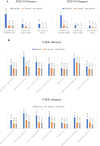Quality of Life After Treatment for Pelvic Organ Prolapse: Vaginal Pessary versus Surgery
- PMID: 37465722
- PMCID: PMC10350403
- DOI: 10.2147/IJWH.S406048
Quality of Life After Treatment for Pelvic Organ Prolapse: Vaginal Pessary versus Surgery
Abstract
Background: Pelvic organ prolapse (POP) is quite common and has an impact on quality of life (QoL). The evaluation of QoL after treatment for prolapse is important. The objective was to compare patient's prolapse symptoms, functional outcomes, and quality of life between pessary and surgery using standardized questionnaires at 1 and 6 months after treatment.
Methods: We conducted a prospective study including women with symptomatic POP who chose pessary or surgery as the first-line treatment. We evaluated QoL using the International Consultation on Incontinence Questionnaire-Vaginal Symptoms and Prolapse Quality of Life questionnaires.
Results: Seventy-two participants were enrolled, with 36 in each group. Body mass index, menopausal status, marital status, number of vaginal deliveries, and stage of pelvic organ prolapse were not significantly different between the groups. At 1 and 6 months after treatment, participants in both groups reported significant improvement in prolapse symptoms, functional outcomes, and overall quality of life. At 1 month after treatment, absolute changes in vaginal symptom scores in the pessary and surgery groups were -16.67 and -19.03, respectively (p > 0.05); at 6 months, the absolute changes were -19.21 and -19.25, respectively (p > 0.05). Significant improvement was only found in role limitation and physical and social domains at both follow-up times after surgery.
Conclusion: At 1 and 6 month(s) after treatment, women with symptomatic POP reported substantial improvement in prolapse symptoms and functional outcomes when treated with pessary or surgical correction.
Keywords: pelvic organ prolapse; pessary; quality of life; surgery.
© 2023 Aimjirakul et al.
Conflict of interest statement
The authors report no conflicts of interest in this work.
Figures


Similar articles
-
Quality of Life after Treatment for Pelvic Organ Prolapse in Real-World Study: Recommendations, Vaginal Pessary, and Surgery.Medicina (Kaunas). 2024 Mar 28;60(4):547. doi: 10.3390/medicina60040547. Medicina (Kaunas). 2024. PMID: 38674193 Free PMC article.
-
Female Sexual Functioning in Women With a Symptomatic Pelvic Organ Prolapse; A Multicenter Prospective Comparative Study Between Pessary and Surgery.J Sex Med. 2022 Feb;19(2):270-279. doi: 10.1016/j.jsxm.2021.11.008. Epub 2021 Dec 27. J Sex Med. 2022. PMID: 34969614
-
Patient-reported goal achievements after pelvic floor muscle training versus pessary in women with pelvic organ prolapse. A randomised controlled trial.J Obstet Gynaecol. 2023 Dec;43(1):2181061. doi: 10.1080/01443615.2023.2181061. J Obstet Gynaecol. 2023. PMID: 36803636 Clinical Trial.
-
Pessaries (mechanical devices) for managing pelvic organ prolapse in women.Cochrane Database Syst Rev. 2020 Nov 18;11(11):CD004010. doi: 10.1002/14651858.CD004010.pub4. Cochrane Database Syst Rev. 2020. PMID: 33207004 Free PMC article.
-
Vaginal Pessaries for Pelvic Organ Prolapse or Stress Urinary Incontinence: A Health Technology Assessment.Ont Health Technol Assess Ser. 2021 May 6;21(3):1-155. eCollection 2021. Ont Health Technol Assess Ser. 2021. PMID: 34055111 Free PMC article.
Cited by
-
Long-Term Compliance of Self-Care Pessary in Symptomatic Pelvic Organ Prolapse.Int Urogynecol J. 2024 Jun;35(6):1263-1269. doi: 10.1007/s00192-024-05806-3. Epub 2024 May 15. Int Urogynecol J. 2024. PMID: 38748222
-
Quality of Life after Treatment for Pelvic Organ Prolapse in Real-World Study: Recommendations, Vaginal Pessary, and Surgery.Medicina (Kaunas). 2024 Mar 28;60(4):547. doi: 10.3390/medicina60040547. Medicina (Kaunas). 2024. PMID: 38674193 Free PMC article.
-
Real-world clinical effectiveness of nonsurgical treatments for female with POP-Q stage II cystocele: a retrospective analysis of therapeutic efficacy.Transl Androl Urol. 2024 Apr 30;13(4):483-492. doi: 10.21037/tau-23-486. Epub 2024 Apr 3. Transl Androl Urol. 2024. PMID: 38721295 Free PMC article.
References
-
- Chuenchompoonut V, Bunyavejchevin S, Wisawasukmongchol W, Taechakraichana N. Prevalence of genital prolapse in Thai menopausal women (using new standardization classification). J Med Assoc Thai. 2005;88:1–4. - PubMed
LinkOut - more resources
Full Text Sources

